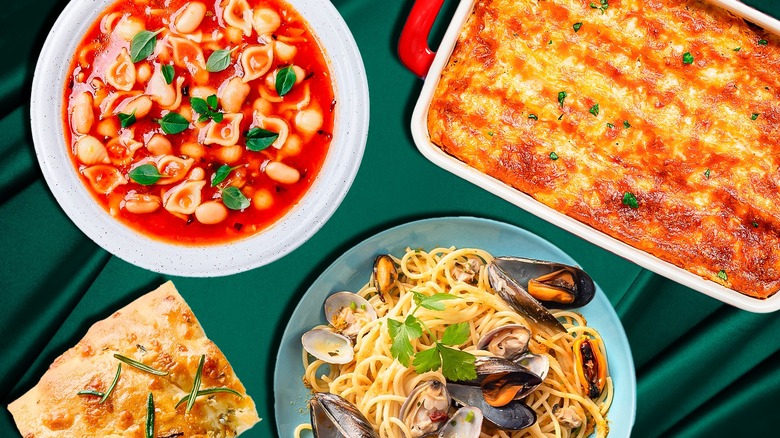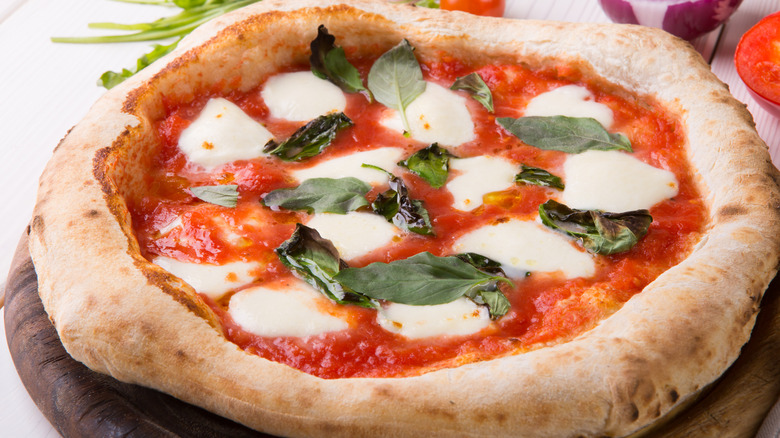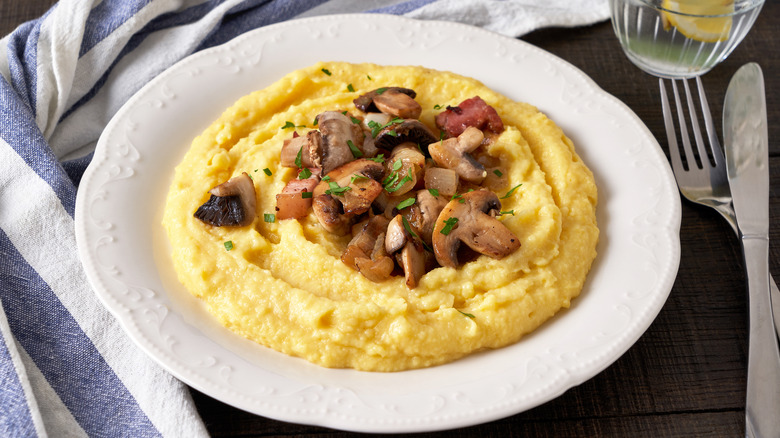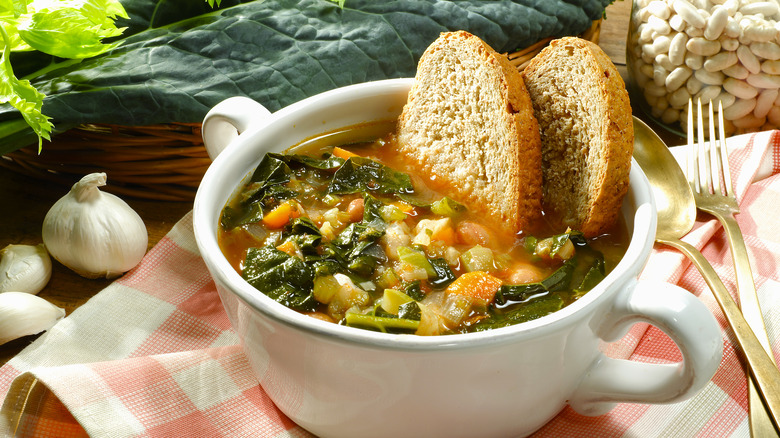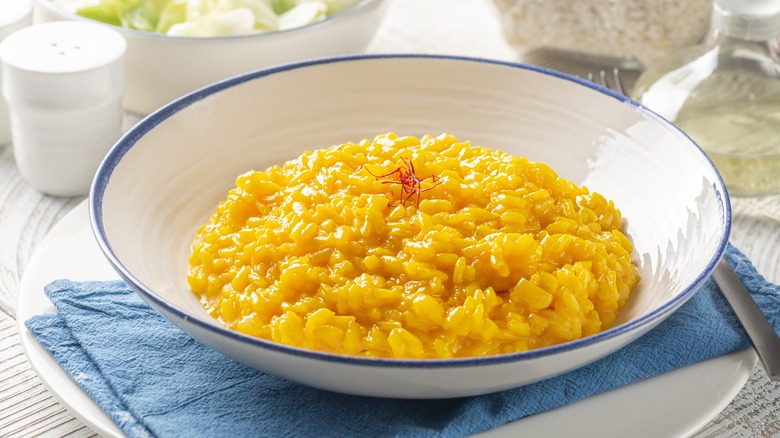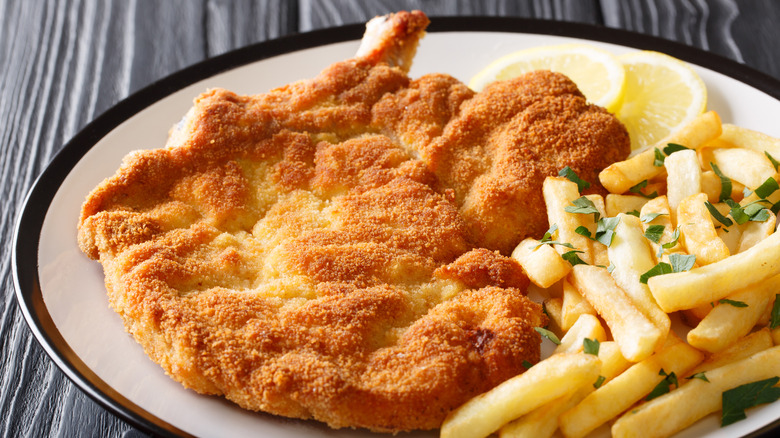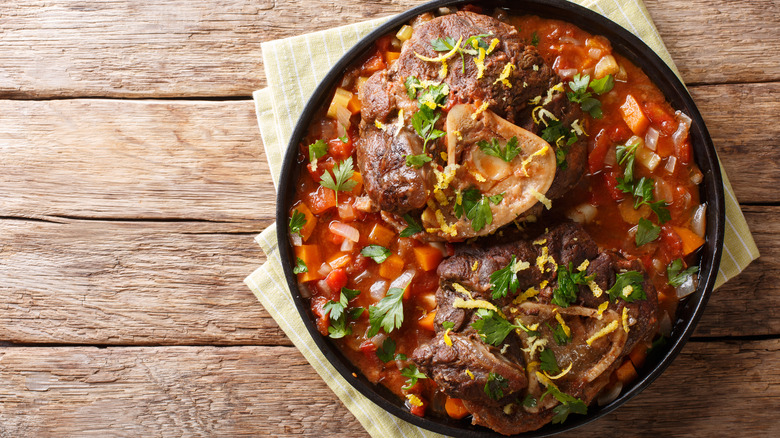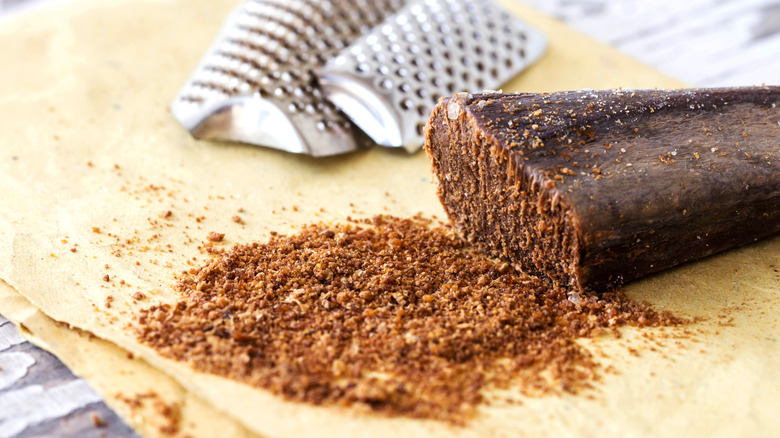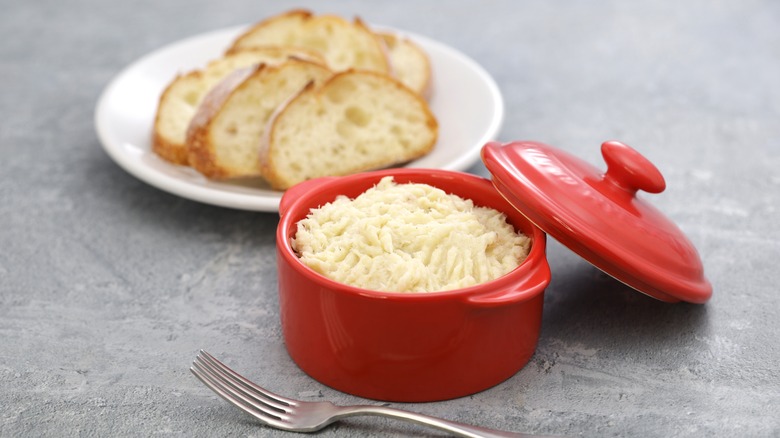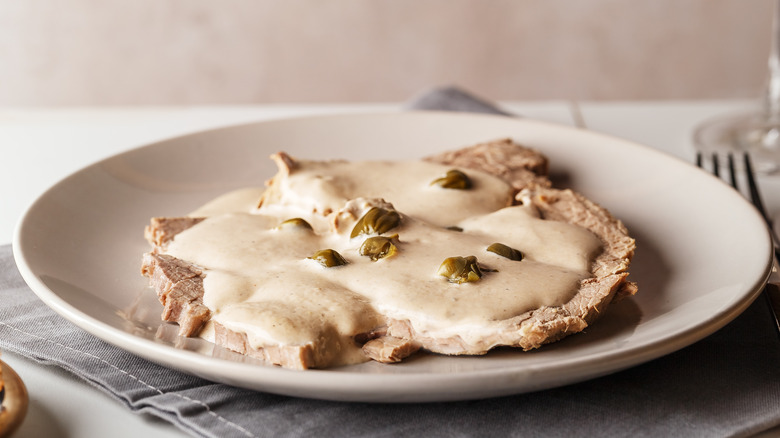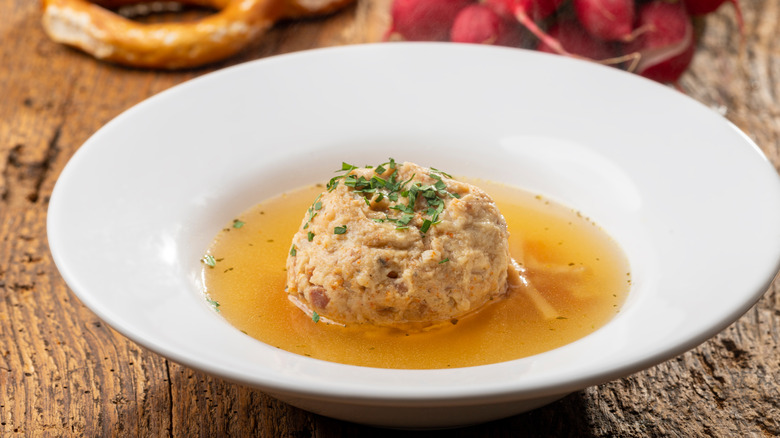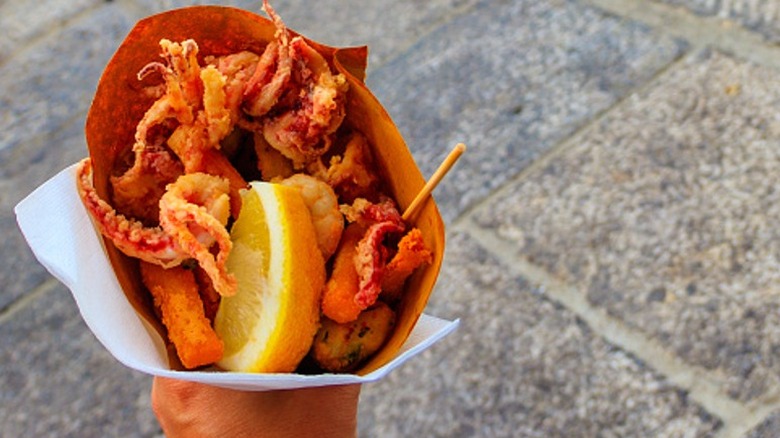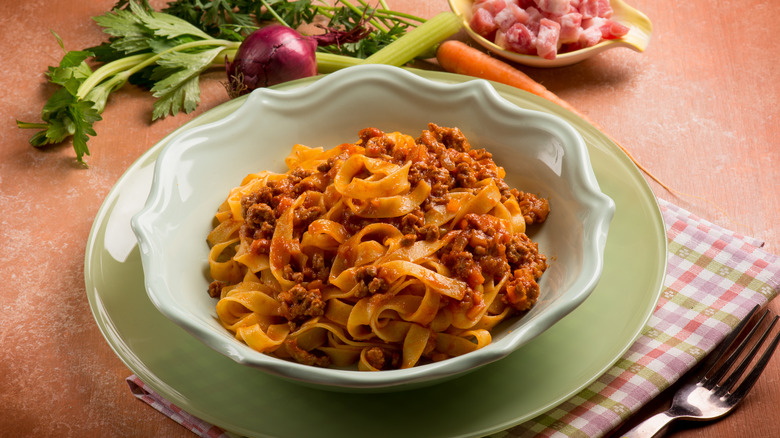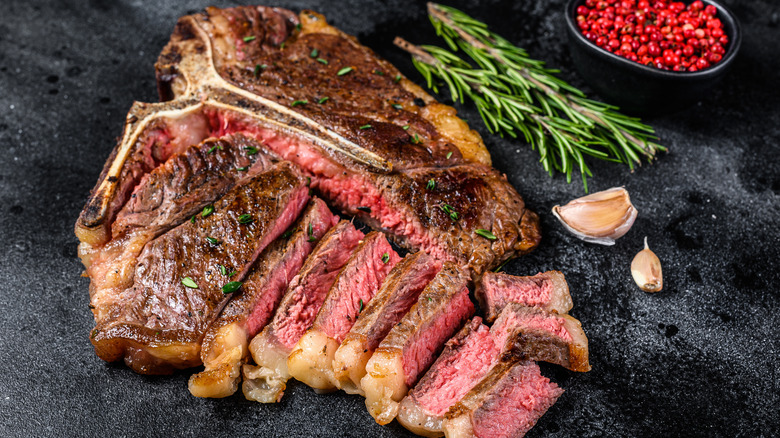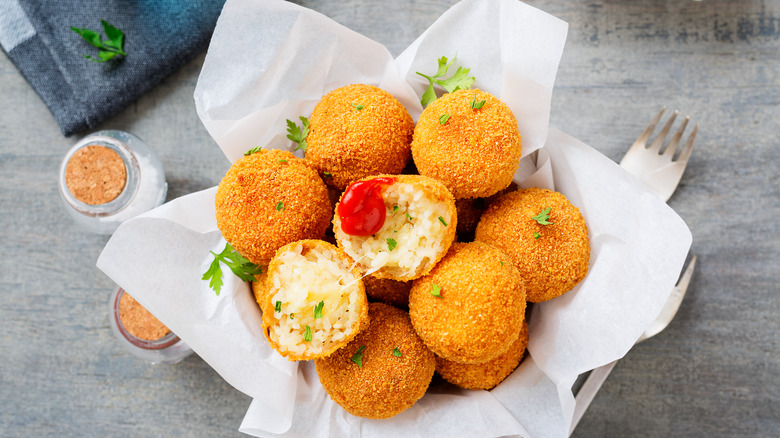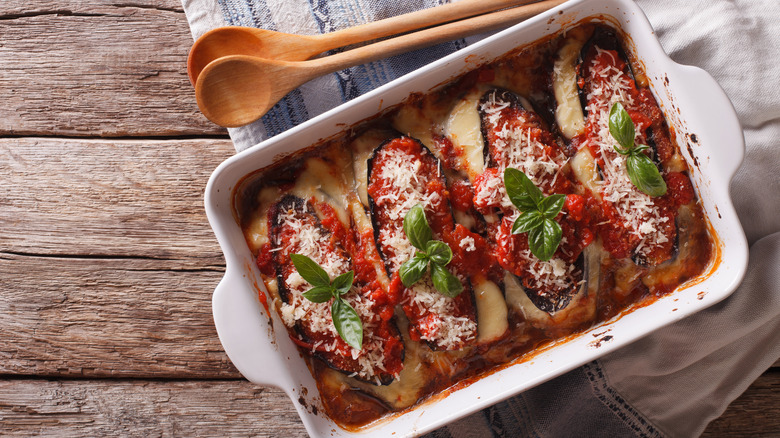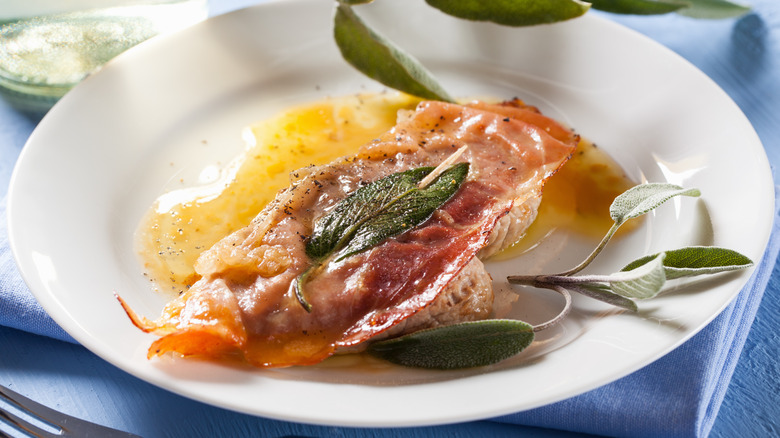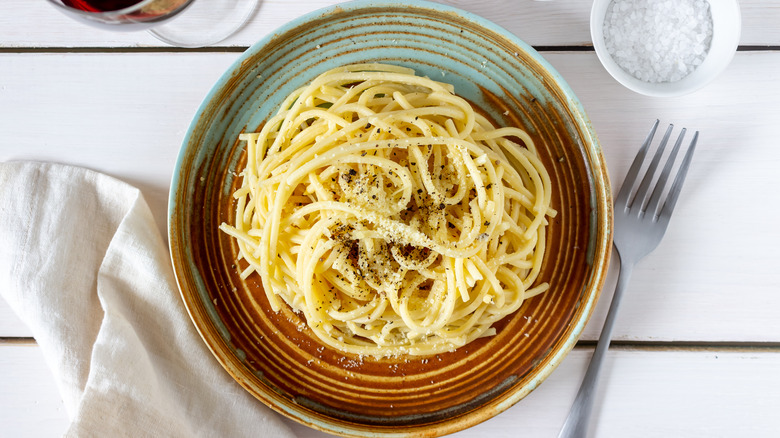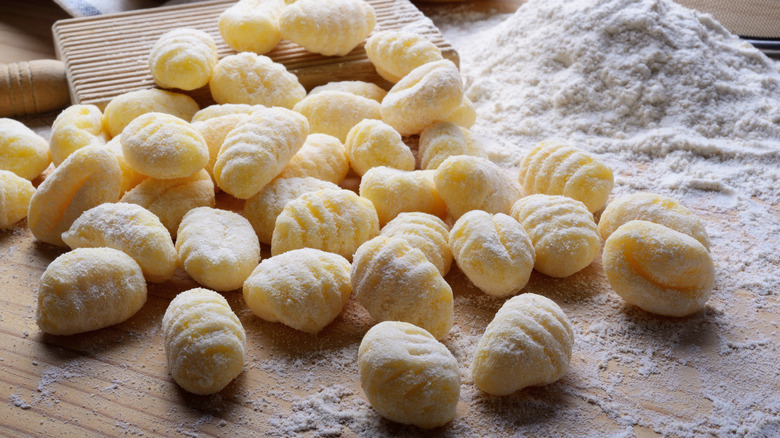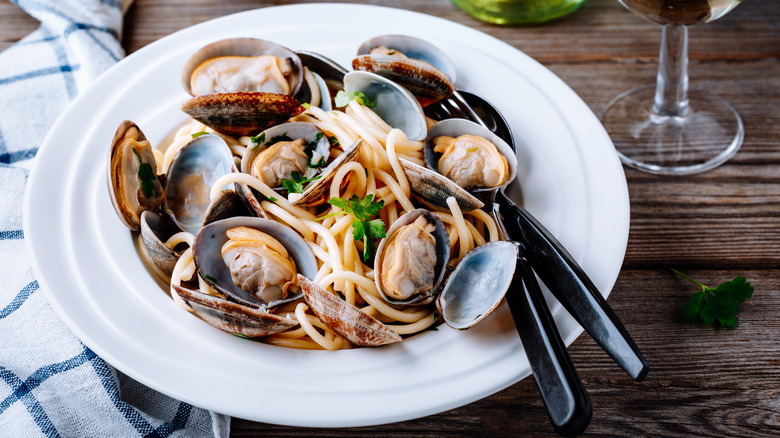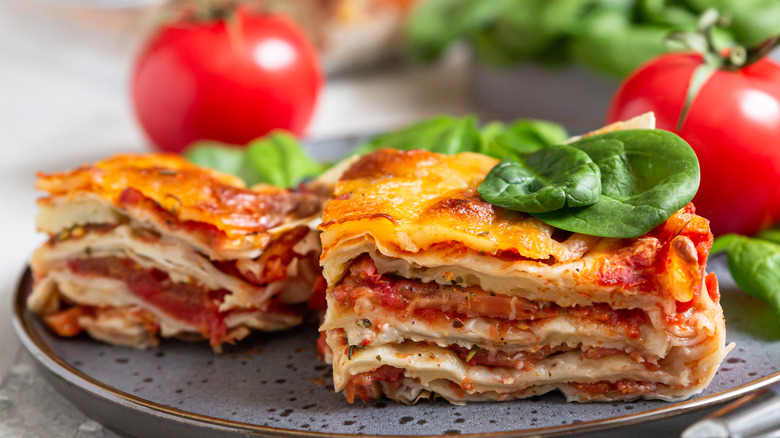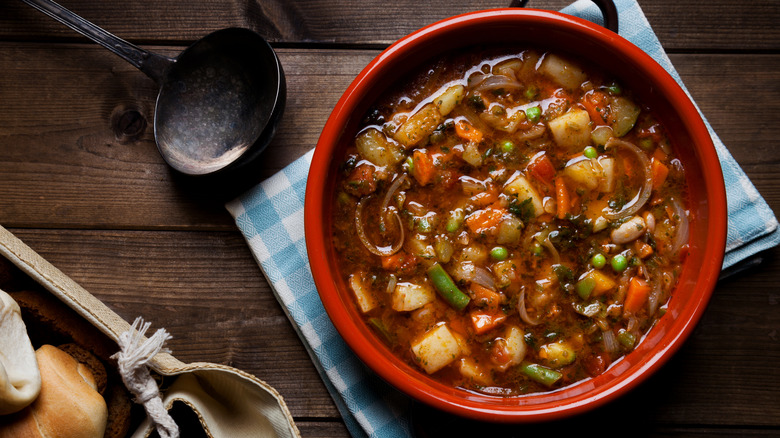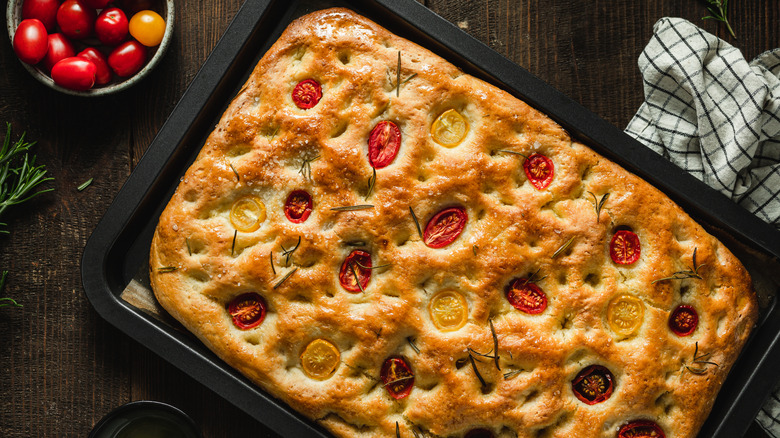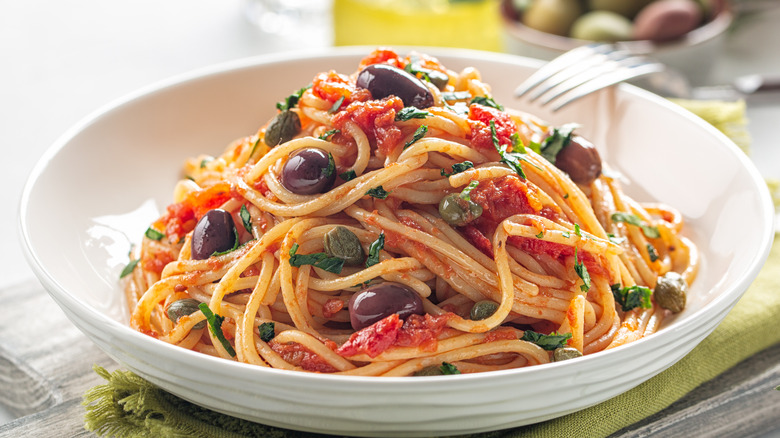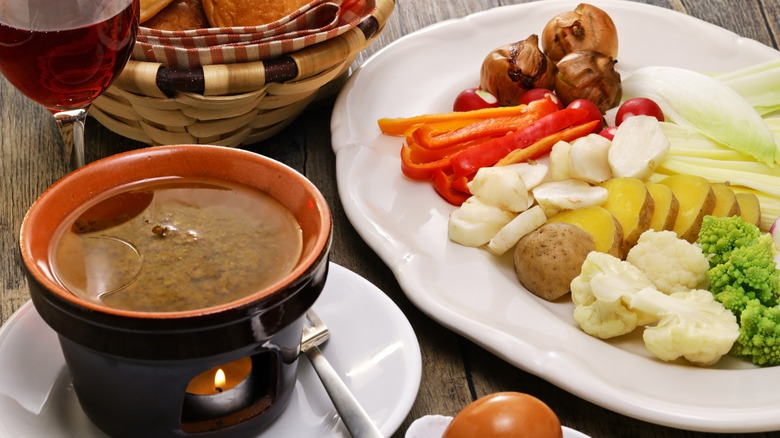25 Italian Dishes You Need To Try At Least Once
It's no secret that Italian cuisine consists of some of the tastiest and most popular dishes around. While pizza, pasta, and risotto variations abound outside of Italy, other items found more regionally are less known. Unless you've had the chance to visit the stunning country, with its endless miles of coastline and mountainous terrain, you might be surprised at its wide culinary variety. Nonetheless, each region of Italy holds certain ingredients and recipes firmly to heart, having perfected them over time.
Of course, favorites like pasta and pizza are worth mentioning, with their unique twists dependent on their origin. However, the vast range of dishes means that you'll always have something new to try when you are in the mood for Italian food. Fresh local ingredients are essential, and if you can source a few items from specialty grocery stores, you are well on your way to trying your hand at making some of these dishes. Although many have been prepared for hundreds of years with often guarded recipes, the flavors are undeniably timeless and satisfying. Becoming familiar with these staples could help you eat like a local in Italy for your next big adventure. Bring an appetite and read on as we share the ins and outs of 25 Italian dishes you have to try.
1. Pizza Napoletana
Let's start with a basic dish that might as well be a universal favorite. Although a wide range of world cuisines serve up a flatbread with toppings, pizza has got to be close to the top of the popularity charts. From thin crust to deep dish, the different types of pizza have all evolved from pizza Napoletana, aka Neapolitan pizza. The name comes from Naples, its city of origin, and the pizza actually has a set of international regulations that must be met in order to label it as such.
While other elements of Italian bureaucracy might appear chaotic or confusing, a strict set of guidelines controls the diameter of the pizza, the width of its raised edge, and the simple yet specific dough ingredients. The method and consequent fermentation of the dough must also meet select requirements. Toppings are simple and star buffalo mozzarella, tomatoes, and fresh basil, the classic ingredients of a pizza Margherita. The pizza must be cooked on a wood-fired stove at high heat for just over a minute.
As for the final result, expect pure deliciousness. Napoletana pizza dough is supple with a puffed edge, soaking up the flavors. A subtle smokiness from the wood-fired oven sets this pie apart from the rest. You're probably better off consuming it with a fork and knife like the locals, but that's a small effort to make for such a tasty reward.
2. Polenta
A glance at an unassuming pot of polenta might not evoke enthusiasm, but the dish is quite a chameleon. Its creamy consistency makes an excellent base for stews, and there are plenty of sweet and savory ways to pep it up. Nowadays, the dish is made with ground corn, ranging from coarse to fine flour, but a variety of grains were used in the past. The flour is boiled in water, producing a porridge-like mash, which is the source of the name (puls being the Latin word for a type of porridge). Unless you're using instant polenta, the mixture needs to be vigorously stirred during the hour or so that it boils.
The corn-based dish is especially popular in the northern provinces, where it has long been a staple of the diet. A simple polenta recipe can taste quite plain, but butter, salt, cheese, or sauces are easy ingredients to enhance the dish. Throughout history, polenta has simultaneously been a filling option for the poor as well as the base of many decadent meals for the wealthy. Tomato, vegetable, or meat sauces are common ways to dress up the creamy mash, but it can take on a completely different texture if it is fried or baked. In fact, fried polenta balls with sugar, raisins, and chocolate are a popular snack during Carnival. Regardless of your flavor preferences, there are so many simple and innovative ways to upgrade polenta for any occasion.
3. Ribollita
Praised for its tall cypress trees and endless rolling hills, Tuscany is also the source of many hearty dishes, one of which is ribollita, a filling soup that will become your new favorite comfort meal. The name means to reboil in Italian, which is exactly what used to be done to it day after day in an effort to stretch it into one more meal. Traditionally, the dish was prepared by peasants who collected scraps of bread soaked with meat juices from luxurious feasts. The bread was then added into a seasoned broth with black cabbage and cannellini beans, topped with daily leftovers to serve it as long as possible. Unlike most bread, Tuscan bread is unsalted and is meant to be eaten with salty food, which makes it a subtle accompaniment to the central flavors of a dish.
While the most basic preparations were made with the few vegetables that could be found locally, present-day renditions include peas, celery, zucchini, and carrots, as well as a generous drizzle of olive oil and grated Parmesan at service. A quintessential hint of black pepper is required for a true ribollita. The soup's consistency can vary depending on its components, and it's not uncommon to use a fork to eat it. You might need one for this slow-cooker chicken ribollita recipe. Even quirkier — traditionally, a few mouthfuls of soup are followed by a bite of onion, the ultimate palate cleanser.
4. Risotto alla Milanese
As far as rice-based dishes go, risotto is certainly a popular option with endless variations, including risotto alla Milanese, so named for its city of origin, Milan. The north of the country has excellent growing conditions for rice, making it the perfect ingredient for local dishes. What sets risotto alla Milanese apart from the rest is its bright yellow color, courtesy of a few strands of saffron that infuse the dish with heady aromas.
The exact history of this risotto dish has a large gap. It first appears in a legend from the 1500s about an overzealous saffron lover who used the spice in a rice dish served at a wedding. However, the source indicates that the actual recipe was only documented in the 1800s, consisting of rice toasted in butter with onions, slowly cooked in stock. Eventually, wine was added to the dish to balance out the rich flavor with some acidity. Risotto alla Milanese is certainly a popular version of the rice specialty — making it an essential for your collection of risotto recipes — and it is often served alongside other regional meals. The creamy dish pairs wonderfully with osso buco or Milanese cotoletta (cutlet).
5. Cotoletta alla Milanese
Cotoletta alla Milanese certainly looks like a Wiener Schnitzel; in fact, the two dishes possibly stem from the same French preparation from the mid-1700s. Nonetheless, some fundamental distinctions separate the two, and you had better not try to order a schnitzel in Milan. Notably, the Viennese dish is often made with pork and covered with both flour and bread crumbs before being fried in oil or butter. The Milanese are the first to state that the dish has been a part of their cuisine since the 12th century. However, since cotoletta comes from the French word côtelette, it's hard to trace back its history under another name.
As for the traditional version of cotoletta (basically the only one considered to be an authentic Milanese cutlet), it uses a bone-in veal loin coated in bread crumbs. The dish is prepared such that the meat won't curl as it cooks — only in clarified butter to be deemed truly Milanese. Copycat versions are made by pounding boneless pieces of veal meat into a thin, crispy cutlet nicknamed elephant ear; however, purists are opposed to the cheap rendition. Cotoletta can be served with risotto alla Milanese or simply with fries or mashed potatoes and some lemon wedges.
6. Osso Buco alla Milanese
Osso buco is one of the more familiar meat preparations when it comes to Italian food. It's no surprise that it's more common to find the dish named in Italian since the English translation amounts to bone with hole. Of course, the delicacy comes from what's inside the hole: bone marrow. The classic recipe comes from Milan, and purists will affirm that it is the only acceptable preparation.
Marcella Hazan, author of "The Classic Italian Cookbook," recommends using a cut from a calf's hind shank as it provides the tenderest meat. The meat is first browned and then slowly braised with a sauté of onion, celery, and carrot, as well as tomato, white wine, and broth. When served, a gremolada consisting of chopped parsley, garlic, lemon zest, and a hint of anchovy can be added over top. Some recipes avoid tomatoes, but they do provide a pleasant acidity to the stew, such as when they're used as a paste in this osso bucco recipe. To reach all of the decadent marrow, a special long narrow fork is used. The dish is filling and wholesome by itself, or it can be served with risotto alla Milanese, which is often cooked with bone marrow broth.
7. Risotto di Seppie alla Veneziana
While risotto alla Milanese is instantly recognizable by its bright yellow color, risotto di seppie alla Veneziana is inky black. In fact, the rice dish from Venice gets its color after soaking in either cuttlefish or squid ink, common in the surrounding Adriatic Sea. The dish is also popular in Croatia, which sits on the other side of the sea. Aside from its striking color, the ink also provides the perfect degree of creaminess, making the consistency of the risotto as heavenly as you'd imagine. While it's easy to be hesitant when faced with a bowl of the stuff, the very best versions are made with the daily catch, so freshness is assured.
Aside from the ink, the cuttlefish itself is cut up into the dish, and the risotto is prepared with the usual suspects: rice, onion, olive oil, garlic, stock, white wine, and some parsley. Tomatoes or chili flakes are also included in some renditions. As for the flavor, chances are you'll enjoy it if you already like seafood since the briny flavor is certainly noticeable; however, a delicate earthiness keeps the taste balanced.
8. Bottarga
With such a lengthy coastline, it should come as no surprise that many Italian specialties display seafood front and center. Bottarga is a sort of Mediterranean caviar since it is, in fact, produced from fish roe. Swordfish and tuna roe sacs are commonly used, although the type of fish depends on the region. Traditionally, the preparation originates from the south of the country, specifically Sicily and Sardinia, although some historians note that it has a history spanning back to the Greeks.
Unlike other popular forms of fish roe, bottarga has been salted and cured, which was once necessary in order to preserve the delicate eggs. Layers of egg sacs are pressed together, cured, and then air-dried. The final product resembles a solid strip, often encased in a thin membrane to keep the texture soft. Cured bottarga can be served in many ways, and it is usually either sliced thinly or grated over a dish, much like truffles or Parmesan. Whether it's sprinkled over pasta, risotto, meat, or vegetables, the salty sea flavor is a versatile way to enhance a meal.
9. Baccalà
Baccalà is the name given to cod that has been salted and dried, a common practice in Italy that dates back to a time when the fish was especially abundant. The popular dish is prepared with dozens of regional variations and is often a mainstay on the table around Christmas time. The cod is soaked, and the salt is washed off before it is prepared, leaving the flavor mild and open to absorbing any seasoning.
Baccalà mantecato, a classic dish in Venice, comes together as the fish is poached with garlic and then whipped with olive oil into a creamy texture that's perfect spread on a slice of crusty bread or served with grilled polenta. Meanwhile, on the coast of Tuscany, the fish is often cooked with tomatoes, garlic, and basil. In Vicenza in the northeast, the cod is simmered with milk, onion, garlic, and anchovies until it is soft and creamy and ready to serve with polenta. Another popular cooking method comes from Naples, where the salt cod is braised with capers, tomatoes, and olives for a decidedly salty meal. With so many regional varieties, this dish proves to be one of intrigue for Italian cuisine.
10. Vitello Tonnato
When it comes to iconic dishes from the north of Italy, vitello tonnato from Piedmont is certainly a must-try. The combination of ingredients might sound peculiar, but trust us, the flavor pairings somehow work. Thin slices of veal are marinated in white wine and boiled. Nothing out of the ordinary here, but the meat is then covered in a creamy tuna, anchovy, and caper sauce and usually served cold. There are variations to the preparation of this Italian tuna sauce, and in some circumstances, homemade mayonnaise can also be incorporated into the sauce.
Surprisingly, the first published account of the recipe as it is today was in a cookbook written by the physician Angelo Dubini, entitled "The Kitchen for Weak Stomachs." The book lists an assortment of simple, affordable meals that are easy to digest, including three versions of vitello tonnato. While veal smothered in a fishy sauce might not be everyone's idea of a dish that's light on the stomach, the preparation is a staple in many areas of northern Italy. Give it a try, and you'll understand why the unexpected flavor pairing receives such praise.
11. Canederli
Italy borders a number of countries, and this is especially evident in the cuisine from the northernmost region of South Tyrol, once a part of Austria. Gone are the coastal vistas; here, towns are scattered around the Dolomite mountains. Consequently, the dining options are significantly different from the rest of Italy, and Austrian and German-style dishes are prevalent. Like knödel, canederli are dumplings made from stale bread, flour, milk, eggs, and speck (smoked pork belly). They are quite easy to make, and since they require very few ingredients, the recipe is a fun one to try out at home.
The dumplings can be served in a broth, with stew or gravy, or simply with grated cheese and butter melted over top. Originating as a thrifty meal for farmers, canederli stem from very little — yet provide plenty of nourishment. While the most basic recipes rely on another dish providing much of the flavor, others incorporate ingredients such as spinach and garlic. Sweet varieties stuffed with apricots or ricotta are also common ways to prepare the doughy balls.
12. Fritto Misto
Frito misto basically translates as fried mix, but the specifics of the assorted snacks vary by region. Along the coastline, seafood is abundant; crustaceans, mollusks, and tiny fish are lightly floured, deep-fried, and served as a crispy snack. In this case, the snack is referred to as fritto misto di mare (of the sea), and a simple sprinkle of salt and a squeeze of lemon juice makes the dish complete. Whether it's the Gulf of Naples in the south or the Adriatic coast in the north, fried seafood is a popular snack.
Meanwhile, in regions inland from the sea, pretty much anything stands a chance of finding its way into a fritto misto. Vegetables, meat, cheese, cookies, olives, ravioli — really, the options are endless. The contents change regionally and seasonally, entirely based on the whims of the chef. In Piedmont, the dish can be as tame as some fried cheese, or it might include veal brains. The snack is often sold streetside in paper cones that soak up some of the oil while you stroll along, enjoying every crunchy bite. As with most fried treats, it's hard to go wrong with a serving of fritto misto, and the versatility of the preparation means that you can keep trying it and never get bored.
13. Ragù alla Bolognese
Whereas spaghetti and meatballs as a dish is purely an Italian-American creation, ragù alla Bolognese is perhaps the original source of inspiration. The name comes from the dish's city of origin, Bologna, and the preparation was first made by one of the pope's chefs. A ragù of minced meat — beef in the official recipe, although pork can be included too — as well as pancetta (or bacon), carrot, celery, onion, tomatoes, wine, milk, salt, and pepper is cooked at low temperature.
Although it seems like a classic meal that must have been made for centuries, the first documented recipe dates to the end of the 1800s. Eventually, to assure the authenticity of ragù alla Bolognese, the recipe was registered in 1982 with the Bologna Chamber of Commerce. Generally, the minced meat sauce is served with tagliatelle, a flat egg-based pasta noodle that is perfect for soaking up the rich ragù. Wider egg noodles such as pappardelle or fettuccine are also commonly served with a ragù alla Bolognese recipe. Unlike the North American preparation with spaghetti, flat pasta allows more surface area for the sauce to stick so that every bite contains chunks of ragù.
14. Bistecca Fiorentina
It might seem fairly basic, but bistecca Fiorentina — beef steak from Florence — is officially considered to be one of Tuscany's traditional food products. Consequently, there are specific requirements as to the type and preparation of the meat. The only breed of cattle permitted for the steak is Chianina, which produces prized lean meat. The T-bone steak consists of both the filet and the sirloin cuts, providing a range of textures to the simple yet delicious dish. Each serving of bistecca Fiorentina weighs a couple of pounds and must be around two inches thick, so it's worth noting that unless you're really hungry, you're better off sharing.
As for the preparation, the beef is dry-aged for a couple of weeks and then seared for a few minutes on a hot grill for a rare finish (the only degree of doneness allowed). A sprinkle of salt and the occasional hint of rosemary or sage are the only seasonings added to the fine steak. At service, a generous drizzle of olive oil completes the flavorful dish; bistecca alla Florentina recipes are typically served with simple sides such as roast potatoes or spinach.
15. Arancini
Who doesn't love a fried snack? Arancini is undoubtedly one of Italy's more popular crispy offerings, and it's not hard to see why. A mound of rice is stuffed with other ingredients such as meat, peas, cheese, or capers, then coated in breadcrumbs and deep-fried, creating a crunchy orange shell. In fact, the name arancini means little orange.
The snack dates back to when the Kalbid dynasty ruled Sicily in the 10th century. The Arabs brought rice to the island and typically flavored it with saffron, which was also introduced under their rule. While this origin story sounds plausible, the first official recipes for arancini date to the 19th century. The fried snack is often sold curbside, thanks to the convenient format of the round or cone-shaped rice balls. There are plenty of creative variations on arancini recipes as far as the fillings go, and sweet arancini made with sugar and cocoa are a popular treat. While you can enjoy the snack year-round, the fried balls are especially popular during the Santa Lucia festivities in Sicily on December 13.
16. Melanzane alla Parmigiana
Melanzane alla parmigiana, aka eggplant Parmesan, has certainly made its way to the U.S. with great popularity. Unsurprisingly, its origin story is somewhat opaque, with people from the city of Parma viewing the dish as being from the north and southern Italians asserting that it comes from Naples or Sicily. Since Arabic people brought the eggplant to Sicily and parmigiana might refer to the word Persian in the local dialect, the southern theory seems more probable. Nonetheless, the lack of documentation and multiple words that might be related to the preparation or ingredients make the origin confusing to pinpoint. However, you'll quickly stop trying to figure it out once you have a bite of this deliciously comforting dish.
So it definitely contains eggplant and cheese, but what else? In the traditional recipe, layers of fried or grilled eggplant are alternated with a tomato basil sauce, and the whole is topped with grated cheese and then baked. Parmesan isn't generally used in traditional recipes and instead, mozzarella, Pecorino, scamorza, or caciocavallo are more common. The same preparation can be made with other vegetables, such as zucchini, but recipes involving baked eggplant are the true classics.
17. Saltimbocca alla Romana
Saltimbocca, which translates as jumps in the mouth, hints at the delightful blend of flavors you can expect. The Roman specialty may have been around earlier, but the first written record dates to the end of the 1800s. Again, some confusion as to the origin exists, since the same dish was already common in the city of Brescia in the north of Italy at the start of the 1800s.
The preparation is simple yet perfectly balanced and consists of pan-fried veal topped with a slice of prosciutto and a fresh sage leaf, held together with a toothpick. The whole is sautéed in white wine or butter. As a meat course, the dish is served with vegetables as a main dish following the pasta course. The ingredients are simple, yet the perfect balance of flavors makes this veal dish a treat — and one that you can easily re-create at home. Such variations can be made based on more common ingredients, such as in a baked chicken saltimbocca recipe.
18. Cacio e Pepe
Cacio e pepe is the proof that you can do very much with very little. Two of the three ingredients are displayed in the name — for anyone who speaks the Roman dialect, that is. Cacio means sheep's cheese (usually Pecorino), pepe refers to a black peppercorn, and the final item is, of course, pasta. Long noodles are best for coating with the creamy sauce, and spaghetti is an easy option though other types are also considered appropriate.
While the ingredients are straightforward, the technique requires some practice. After cooking the pasta, some of the starchy water is stirred into the pasta with the grated cheese until the sauce emulsifies. There's plenty of room for error, but if the ideal conditions are met, the result is purely delicious. Finally, a generous crack of fresh black peppercorn adds a kick.
As always, the origin story is fuzzy, and whether the dish was perfected by shepherds with minimal supplies or by poor factory workers in the city is anyone's guess. Nonetheless, a well-prepared plate of cacio e pepe pasta will leave you dreaming of little else. While it stems from a thrifty way to enjoy a nourishing meal, you can easily find luxed-up versions at restaurants where it is prepared tableside from inside of a wheel of cheese.
19. Gnocchi
While gnocchi is often served with sauce, much like pasta, it is composed of entirely different ingredients. The little plump dumplings are traditionally made from potatoes, which grow well in the cooler climate in the north of the country. Traditional potato gnocchi likely originated sometime around the 17th century since the root vegetable was not introduced until then. The basic recipe requires a bit of flour to help shape the mounds, and many variations include an egg as a binder. Alternate versions made with spinach, ricotta, pumpkin, corn flour, semolina, or bread are also typical in certain regions.
A simple tomato sauce is a popular pairing, but subtler flavors, such as melted butter with fresh sage or cream sauces, work well with the dumplings. Delallo notes that on the island of Sardinia, a sausage-based sauce is typical, whereas bacon, prosciutto, or vegetable blends are great options. Basil pesto also makes an excellent match for the neutral potato flavors. Ultimately, it's hard to go wrong, which makes sense considering its one of the most popular Italian dishes around.
Gnocchi is traditionally served in restaurants on Thursdays, so keep that in mind if you are visiting Italy and want to fit in with the locals. The custom stems from the Catholic tradition of skipping meat and only eating fish on Fridays. Filling up on a simple starchy meal the previous day was deemed a good way to prep for a day without meat. To get some practice at home, try this crispy gnocchi recipe.
20. Spaghetti alle Vongole
As far as iconic Neapolitan dishes go, spaghetti alle vongole (with clams) is high up on the list. Being a city by the Mediterranean, Naples is the perfect location for dishes showcasing the briny flavors of the sea. Simple, classic, and easily one of the best meals you'll have if it's properly made, spaghetti with clams requires very few ingredients. The main elements are already in the name, and the dish is finished with olive oil, garlic, and parsley. The pasta is first cooked al dente while the hard clams are lightly steamed, then the two are combined together with the rest.
Taste Atlas notes that a few components of the dish are up for debate. While some people swear by adding crushed or cherry tomatoes, others oppose the addition of tomatoes, preferring the traditional bianco (Italian for white, to describe the dish's color). Some people add chili flakes to complement the flavors, yet once again, it depends on who you ask. As for the pasta shape, spaghetti is probably the easiest to find, but the dish was originally made with thinner strands (vermicelli) and is regularly served with linguine or other long noodles. Unlike many Italian dishes that require baking or slow cooking, a linguini and clam recipe can be thrown together relatively quickly.
21. Lasagna
Although lasagna is well-cemented as a staple Italian food option locally and internationally, it owes its first variations to Greek cuisine. Nowadays, the dish has expanded to encompass dozens of styles, with plenty of meat and plant-based versions to appeal to the masses. The standard recipe made with bechamel and meat ragu is thought to come from the Italian region of Emilia-Romagna. Other variations with ingredients such as sausage, hard-boiled eggs, meatballs, ricotta, and pesto, can be traced back to different provinces of Italy, and it seems like there's a new lasagna recipe created every month.
Regardless of the components, the layering technique is one element that never changes. You'll find long rectangular lasagna noodles, cheese, tomato sauce, meat sauce, bechamel, and vegetables in the various layers. While there is some debate as to how many layers a lasagna should have, the consensus is between three and five. The layers are prepared individually and layered in a deep baking dish, then baked in the oven until the cheese is melted and golden brown. Try this classic lasagna bolognese recipe.
22. Minestrone
It doesn't get much more heartwarming than a bowl of minestrone, especially if it's homemade by a nonna. The soup became widespread among the Romans as early as the 2nd century BC, and it hasn't shown any signs of letting up. Consisting of a mismatched assortment of ingredients, minestrone can take on many different forms depending on what is available. For this reason, it has traditionally been considered a peasant dish, though in practice, it is simply a versatile recipe that can be endlessly customized.
A good minestrone is decidedly chunky, with a flavorful broth loaded with tender pieces of meat, vegetables, and pasta or rice. Common ingredients include onions, carrots, and celery to make a base, then tomato, zucchini, squash, potatoes, leafy greens, and some type of small pasta such as short tubes or macaroni to round it out. Some versions, such as Tasting Table's hearty minestrone soup recipe, also include white beans to turn it into an even more satiating meal or scraps of leftover meat.
23. Focaccia
What's not to love about focaccia, the simultaneously doughy and light bread? If you've collapsed it into the pizza category in your mind, it's time you placed it into a realm of its own. As a version of flatbread that eventually paved the way for pizza, focaccia dates back to a time before the Roman Empire, when it was likely enjoyed by the Etruscans and Greeks. The flatbread changed over the centuries that followed, with both leavened and unleavened recipes.
The variation that is most recognizable as focaccia internationally developed in Genova, Liguria in northwest Italy in the 16th century. Known as focaccia genovese, the base recipe is simply seasoned with salt, olive oil, and rosemary. Other versions include extra ingredients like cheese, olives, and tomatoes. Potatoes can be mixed into the dough, creating a weightier bread. There are sweet variations, too, with raisins and caramelized sugar, for example. You'll find bakeries that serve large rectangular slices of focaccia or use it as a foundation for a hearty sandwich, but you can also bake an easy focaccia recipe at home.
24. Pasta puttanesca
While there are endless Italian pasta dishes to try, puttanesca is a definite classic yet less popular internationally than, say, carbonara. If you speak a Latin language, the name might sound curious to you, and indeed, it has been the source of much speculation. As a derivative of the Italian word for prostitute, one might wonder what led to the creation of such a dish. Well, the theories are inconclusive; some suggest it may have first been made in a brothel, while others look to the alternate meaning of the word as an exclamation, in this instance, customers asking a chef to whip up whatever he could with the ingredients at hand.
Regardless of the backstory, one thing is certain about this Neapolitan recipe: Pasta puttanesca is a flavor-packed dish that deserves a seat at any table. The recipe consists of garlic, chili peppers, diced tomatoes, tomato paste, olives, capers, and anchovies in some variations. The result is salty and briny, with a rich mouth-coating flavor from the saucy tomatoes and an herbal accent from the parsley garnish. Spaghetti works well to highlight this savory sauce, though other shapes, such as in this puttanesca recipe, can stand in, too.
25. Bagna cauda
This classic specialty from Piedmont incorporates basic ingredients to make a delightful dish traditionally enjoyed by large groups of farmers following a hard day of work. Commonly prepared and enjoyed following fall grape harvests with ingredients from the land, the recipe includes vegetables, garlic, olive oil, and salted anchovies. Although its origins can be traced back to Provence, France (the original source of the salted anchovies), the dish is a mainstay of Piemontese cuisine. Bagna cauda translates to "hot sauce" in Italian, which is a reference to how the dish is served (warm, not spicy!).
Typically, the sauce is prepared in an earthenware pot by slow-cooking tons of garlic, olive oil, and anchovies. The ingredients soften and thicken and are sometimes enhanced by other ingredients like butter, cream, or ground nuts. Raw or cooked vegetables are served alongside a bagna cauda recipe to be used for dipping. Among the usual suspects, you'll find carrots, turnips, radishes, cauliflower, potatoes, and peppers.
